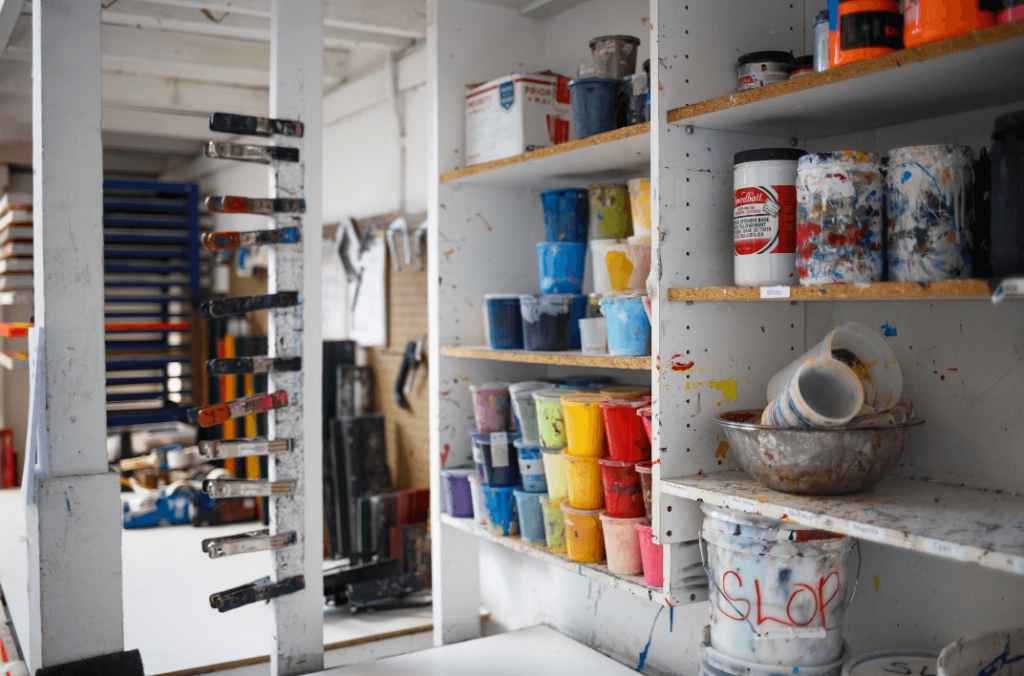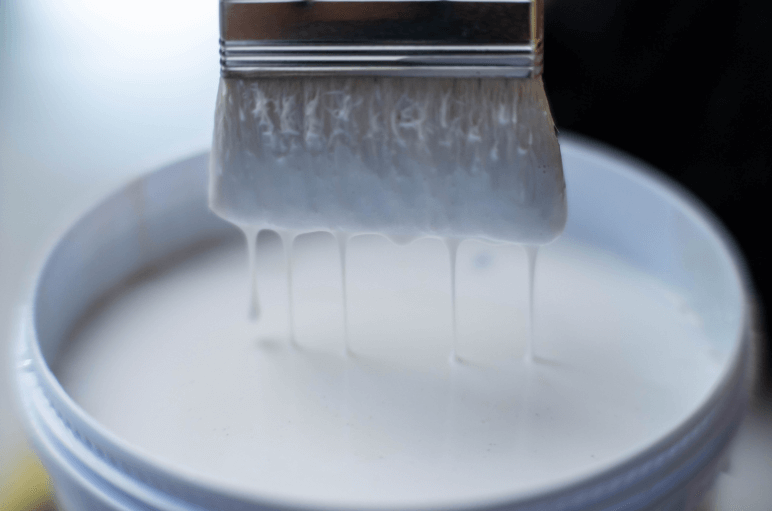Paint is more than simply a material used to cover walls; it's also a medium for expressing oneself, sprucing up one's living space, and contributing to creative endeavours. Professional painters, do-it-yourselfers, and artists agree that good paint is critical to a job well done. But have you ever thought about the importance of paint storage in keeping your paint looking fresh for as long as possible?
Paint storage is an often-overlooked art form in colours and coatings. Many people keep their paint in less-than-ideal circumstances, which might ruin their favourite colours. However, it may make a considerable difference to learn about and put into practice the best methods for storing paint.
This blog will explore the complex topic of paint conservation. This article will discuss why and how paint storage may significantly affect quality and longevity. We'll reveal the keys to keeping your paint looking as good as the day you purchased it, from the environmental elements that affect paint to the choice of containers and safety precautions.
If you've ever wondered how to store your paint correctly or need help opening a can to find clumpy, useless colours, this blog will teach you all you need to know. Come along as we explore the world of paint and discover the secrets of keeping it in pristine condition.
Types of Paint: Everything You Need to Know
Latex (Water-Based)
The word latex paint is commonly used to refer to water-based paint in a more casual context. Unlike oil paints, which employ mineral turpentine as a carrier, this one uses water as its main ingredient.
Latex, or water-based, paints are adaptable and long-lasting and come in various hues and finishes. They are considered better for the environment because they produce less emissions throughout the painting and drying process.
Tip: The quality of these paints will suffer if they are stored at or below 32 degrees Fahrenheit. If your building is perpetually chilly, it would be wise to invest in a heating system.
Solvent-Based
Paints that use organic molecules as solvents are called solvent-based. The chemical components provide a tough coating that isn't easily damaged by everyday use. Thinners like mineral spirits or turpentine must be used to clean and thin solvent-based paint. The thicker consistency helps paint conceal wall flaws but requires patient drying time.
They function better in subfreezing temperatures and other climates because they resist such situations. These paints' volatile organic compounds (VOCs) are potent enough to produce severe headaches, breathing difficulties, and a general sense of being ill. Moreover, they have a strong scent that might be distressing to young children. Combining these features makes them superior to other coating options for use on the outside.
Tip: These paints may be stored at any temperature since they won't freeze. However, they should be stored in a dry, clean place.
Powder Coating Paint
In the powder coating process, an electric charge is applied to the metal's surface, causing a dry powder to fuse to it. A curing oven is used to bake the coating into a uniform consistency. It's typically used to make a tougher-than-normal paint finish.
Powder coating is superior to liquid coatings in terms of thickness since it does not require a liquid carrier. It also minimises the visual disparities between horizontally and vertically covered surfaces.
Tip: Extreme care must be taken to maintain less than 50 per cent humidity and temperatures below 80 degrees Fahrenheit when storing this substance. Increased moisture negatively impacts the powder's performance and causes it to clump.
Is the Garage a Good Place to Store Extra Paint?
It's common practice to store unused paint in the garage, assuming it will be OK for future use. The discovery that the paint has gone bad upon opening might come as a shock. Proper storage may extend the life of paint for up to five years, so it's vital to remember that.
To preserve its uniformity and quality, the paint should be kept in a cool, dry place, between 60 and 80 degrees Fahrenheit. Store it in a dark, dry, and out-of-the-way location, like a utility closet or a locked cabinet. Although you may keep leftover paint in a garage, consider the local weather and whether you can regulate the temperature to keep it from freezing or thawing.
It's best to keep full paint cans on a sturdy industrial shelving unit, low shelves, or floor to prevent mishaps and spills. Paint cans of lesser size and weight can be placed on upper shelves. Keeping any leftover paint materials in one place can help you stay organised, save you from making any unplanned purchases, and simplify working on future projects. Paint should be kept securely away from curious hands and paws.
How to Properly and Securely Store Excess Paint
It is expected to complete a painting job with some paint left over. Every year, a shocking amount of unused paint is dumped in landfills. There should be no need to throw away paint. Any leftover paint can be used for future touch-ups or DIY projects.
How to Preserve Paint Quality
Properly storing paint entails more than merely replacing the car's cover. Here's how to keep unused paint usable for as long as possible:
Prevent the Air from Getting Into the Container
Although it may seem like common sense, the paint can is crucial to appropriately storing paints. Which material, then, is most suited for containing paint? Storage containers with sealed covers are ideal for keeping paint from drying out. The container might be a glass or plastic bottle with a metal or plastic cap. These canisters are inert, so they won't adversely affect the paint or other chemicals in the room. If you don't have containers like this, keep your paints in something that won't let moisture in. It ought to be big enough so oxygen can't get in and oxidise the bottle's contents.
Do Not Forget to Label the Storage Containers
Labelling each paint can with the room or rooms is essential if you have recently concluded an interior painting project. If you're making touch-ups indoors, this will save you the trouble of opening each can of paint to verify the shade.
The paint colour code and the corresponding number both need to be preserved. This is crucial so the paint shop can provide the correct paint if you run out. Paint cans should also clearly state whether or not the paint's recipe has been changed.
Whether it's meant for inside or external use might also be noted.
Repackage into Tinier Containers
Paint should be transferred to a smaller container if a tiny amount remains in the can. Preserving tiny amounts of unused paint in clean glass jars for later use is also a good idea.
- When storing paint, a smaller container with less air is preferable.
- Less space is needed to store smaller containers.
- Paints stored in clear glass containers allow quick visual inspection of the remaining volume.
Keep in a Dry, Cool Place
The best approach to extending the life of paint is to keep it out of heat and light. Paint needs to be kept between 60 and 80 degrees Fahrenheit, as most manufacturers suggest. It should be kept in a dry, dark, cool place like a basement, utility room, or closet.
Safeguard Young Ones and Pets
Keep any remaining paint away from curious hands. Keep any paints, solvents, and chemicals locked up if small children are in the house.
When It Is Time to Use the Paint You Have on Hand
You can do a few things to prolong the remaining paint's usability.
Verify for Consistency
After being kept for a while, latex paint will inevitably form a film on top. Paint that has hardened into pieces or turned jelly-like cannot be remixed. Forget using paint that has hardened into anything thicker than a film.
Inspect the Paint for an Unpleasant Smell
You should be able to detect some of the original chemical smell in a reopened paint can or jar. The presence of a rotten egg odour upon opening a paint container indicates the presence of germs and means that the paint should not be used. A musty or mouldy odour may also develop in paint. No paint with a rotten or otherwise unpleasant odour should be used.
Get a Professional Remix Done
Have your paint mixed at your local paint store when needed for a short touch-up or other project. Resins separate from water and other paint constituents and settle when stored. The machine at the paint store can mix it better than you can by stirring or shaking it by hand. This service is usually offered at no cost and is highly recommended.
How to Properly Dispose of Paint Waste
Any unused paint should be disposed of correctly and following local regulations. Find out the rules in your community for properly discarding or recycling empty paint cans. Consider donating any unused full cans you have.
Also, latex and oil paints have different disposal requirements; read the labels on the cans to be sure you're using the proper technique. If the latex paint is dry, it may be thrown out with the ordinary garbage in most communities. This needs some drying or hardening process. Extra paint can be poured onto a cardboard or other disposable surface, dried entirely in the air, and discarded.
To dispose of any remaining paint by local regulations, leave it in the container, remove the lid, and let the paint dry thoroughly. If you have a lot of leftover paint that you don't want to keep but can't get dry, a paint hardener from the hardware store is a beautiful option. It's a cheap powder mix that may be added to liquid paint to simplify cleanup and disposal.
Oil-based paint waste cannot be thrown away in the garbage since it is toxic and might contaminate other materials. Safely disposing of oil paint requires following your municipality's guidelines, which may include a drop-off location for hazardous trash or designated collection days.
Don't Store Too Much Extra Paint if You Can Help It
Estimating how much paint you'll need for a job before you begin is essential so you don't end up with too much leftover and squandering it (and your money).
You can find a paint calculator on the websites of most major paint dealers, and you'll often find one in-store as well. Buying extra paint for touch-ups and several coats is a good idea, but it's crucial to prevent too much paint left over by accurately measuring the space and estimating the amount of paint needed.
Conclusion
Paint is an important tool for expressing yourself, making your home look better, and being creative. How you store paint can have a big effect on its quality and longevity. This blog discusses how important it is to preserve paint by discussing the environment, container options, and safety measures.
Paint comes in three types: latex (water-based), solvent-based, and powder finish. Latex paints can be used in many ways, last a long time, and are safe for the earth. They need to be kept at or below 32 degrees Fahrenheit. Solvent-based paints, on the other hand, use organic molecules as solvents. If you want to use powder coating paint, you need temps below 80 degrees Fahrenheit and less than 50% humidity.
The garage is an excellent place to keep extra paint because it can last up to five years there. Keep the paint in a cool, dry place between 60 and 80 degrees Fahrenheit to keep it consistent and of good quality. Keep it somewhere dark, dry, and out of the way, like a locked cabinet or utility room.
To safely and properly store extra paint, you should consider the weather and how the temperature is controlled in your area to prevent the paint from freezing or melting. Heavy-duty industrial shelving units, low shelves, or the floor are all excellent places to store full cans to avoid accidents and spills. Paint cans that are smaller or lighter can go on the upper shelves.
Protecting paint quality means more than just getting a new car cover. It also means keeping the paint's colour, texture, and resilience.
Use sealed containers to store paint properly, like glass or plastic boxes with metal or plastic caps. This will keep air out of the container. Please write the name of the room or rooms painted on each can and keep the paint colour code and number that goes with it. If a tiny amount is still in the can, put it in smaller containers and store it in clean glass jars until you need them again.
Paint must be kept somewhere dry and cool, between 60 and 80 degrees Fahrenheit. Children and pets should not be around it. Check the paint for consistency and smells to see if they are unpleasant. It's no longer suitable when the paint has broken up or turned jelly-like.
If you need a quick touch-up or something else, you can get a professional remix at a paint shop near you. Resins separate from water and other paint ingredients; when they are kept, they settle down. Follow local rules for adequately removing paint waste, such as giving full cans that haven't been used and following local rules for latex and oil paint waste.
To avoid wasting paint and save money, it's essential to guess how much you will need before you start. A paint calculator can be found on websites or in major shops. Be sure to accurately measure the area and guess how much paint you'll need to avoid buying too much.
Content Summary
- Paint storage ensures longevity and quality retention.
- Proper paint conservation can prevent wastage.
- Discover the keys to maintaining paint freshness.
- Correct paint storage techniques can prevent clumps and ruin.
- Latex paint, commonly water-based, is environmentally friendly.
- Avoid storing latex paints below 32 degrees Fahrenheit.
- Solvent-based paints offer a tough finish.
- They are resilient in freezing temperatures and adverse climates.
- Solvent-based paints have strong, potentially harmful odours.
- Powder coating provides a durable paint finish.
- Store powder paints below 80 degrees Fahrenheit and low humidity.
- Your garage can be suitable for paint storage with the right conditions.
- Maintain a temperature between 60 and 80 degrees Fahrenheit for paints.
- Store paint in a dark, dry, and cool place.
- Full paint cans are best stored low to prevent spills.
- Keep leftover paints organised for future use.
- Ensure paint is kept away from children and pets.
- Use smaller containers to store small paint quantities.
- A sealed container preserves paint quality by limiting oxidation.
- Label your paint containers for easy identification.
- Record paint colour codes for future reference.
- Transferring paint to glass jars ensures minimal air contact.
- Basement or utility rooms are ideal for paint storage.
- Check stored paint for consistency before reuse.
- Disregard paint with unpleasant or mouldy odours.
- For best results, get stored paint remixed at a paint store.
- Proper paint disposal adheres to environmental guidelines.
- Differentiate between disposal methods for latex and oil paints.
- Consider donating unused paint cans.
- Use paint hardeners for a more straightforward disposal of leftover paint.
- Oil-based paints require particular disposal due to their toxicity.
- Accurately estimate paint needs to avoid excessive leftovers.
- Paint calculators can help you gauge the required amount.
- Leftover paint is perfect for touch-ups or small projects.
- Air-dry any extra latex paint before disposal.
- Use a paint hardener for easier cleanup and disposal.
- Paint, more than just a covering, expresses creativity and style.
- Store paints in a location safe from curious hands.
- Paint stored correctly can last up to five years.
- Avoid wastage by using paint calculators from major paint brands.
- Organic molecules act as solvents in solvent-based paints.
- Powder coatings eliminate the need for liquid carriers.
- Store solvent-based paints in a dry and clean environment.
- Powder paints offer reduced visual disparity on surfaces.
- Learn to maintain the integrity of your paint supply.
- Adequate paint storage is crucial for both professionals and DIY enthusiasts.
- Securely storing paint helps maintain its original quality.
- Choose storage containers that repel moisture effectively.
- Regularly inspect stored paints to check their usability.
- Take a proactive approach to avoid excessive paint storage.
Frequently Asked Questions
Yes, it's generally acceptable to store paint in the garage. However, proper storage conditions are crucial to maintain its quality.
Yes, paint can freeze if exposed to extremely low temperatures. Protecting your paint from freezing is essential, which can alter its consistency.
Store paint away from direct sunlight and hot spots in your garage. Excessive heat can cause paint to deteriorate or become unusable.
Labelling paint cans is essential for easy identification. Include details like colour, date of purchase, and the project it was used for.
Keep paint out of the reach of children and pets. Store it away from open flames and heat sources to prevent fire hazards.


